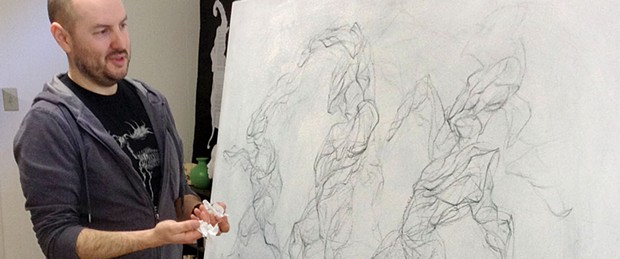[
{
"name": "Top Stories Video Pair",
"insertPoint": "7",
"component": "17087298",
"parentWrapperClass": "fdn-ads-inline-content-block",
"requiredCountToDisplay": "1"
}
]
At first glance, the pencil strokes on the canvas look like the outlines of an unfinished project. "So, what do you see?" Brent Eviston asks, pointing to the abstractly posed figures of the drawing. Then it starts to pop out. It's a rabbit. Or maybe it's people dancing. Or maybe they're fighting. Regardless, the figure to the left is definitely a rabbit. "There are no wrong answers," he assures me.
Brent Eviston's studio, a converted one-car garage connected to his home, is a testament to his nerdery. The walls are sporadically covered in various pieces of art, every surface containing some sort of work in progress, and standing watch from the center of the room is a life-sized, educational human anatomy model. When told that a phrenology bust would really tie the room together, he smiles and matter-of-factly says, "I know!" This is the room where his fascination with neuroscience and his love of art come together and create something provocative. His most recent collection, Apophenia, perfectly exemplifies the sort of curiosity that underlies this convergence of fascinations. It's two-fold: On the one hand, he considers drawing to be a "record of what the artist was thinking," while on the other hand, he sees it as an account of what the viewer is perceiving.
The word "apophenia" means finding patterns and connections in randomness. It's a concept closely related to pareidolia, which is the phenomenon that occurs when people are able to see faces or figures within other visual stimuli. It's a very common occurrence: finding animals in clouds, seeing the "Man in the Moon" or discerning Jesus' face on a piece of burnt toast. Neuroscientists theorize that humans may be hardwired to find faces in their field of vision. It makes sense if you think about it. It's evolutionarily advantageous to be able to pick out the presence of other people and to have an extra few seconds to respond to the possible threat of attack. Eviston took these concepts and ran with them.
It starts with small scraps of white printer paper. Together with his wife, Eviston crumples, crushes and crunches the small slips of paper, allowing them to take whatever random shape might occur. Then, he treats the scraps like a figure study, drawing them in highlighted and shadowed detail onto the surface of the canvas. He looks at figure drawing as "monumentalizing minutae." Like a meditation, he captures angle, crevice and peak of a figure in pencil. He applies this process to his scraps of paper just as he would if he were drawing from a human subject. Every detail he captures is something else that the audience may interpret differently.
Those interpretations are the backbone of Eviston's Apophelia show and his last few projects (which you can view at www.brenteviston.com). Every person who views any work of art brings his or her own personal experiences, emotional baggage and biased opinion to what he or she is seeing. Some may look at Van Gogh's "Starry Night" and focus on the sun and moon, while others may fixate on the whirls of the clouds. Those differences in personal focus and interpretation are alluring to Eviston.
Standing in front of the 3-foot-by-6-foot canvas with its three "figures," it only takes a second for faces and bodies to form. From there, it's easy to construct a narrative or meaning to the figures, creating a story where previously there were only abstract shapes. A rabbit and two figures dancing? A rabbit and two figures walking like Two Wild and Crazy Guys from Saturday Night Live? Two discus throwers chasing a rabbit? What if that isn't even a rabbit?
On the surface, Eviston has created abstract drawings from randomness, but his real creation comes from a deeper place. He is creating a thought process for his audience, one that can be examined at a metacognitive level. Viewers get some insight into what they think about the way they think and an opportunity to see the connection between what they see and what they perceive. That key difference between sensation and perception is such a personal, human aspect of how and why we like or dislike art. Eviston encourages you to hone in on that human aspect of creativity and curiousity, with a little lesson in neuroscience to boot.
Brent Eviston's Apophelia opens at the Upstairs Gallery (1063 G St.) during Arts! Arcata on Friday, May 8, when Eviston will show a short, explanatory film on one wall of the gallery. This extra bit of insight into the artist's motivation should be a treat and a rare opportunity.
more from the author
-
Paul Reiser is Back at the Mic
- Sep 8, 2022
-
Paul Reiser is Back at the Mic
- Sep 7, 2022
-
Poundstone on Pandemic, Politics and Priorities
- Jul 28, 2022
- More »


































